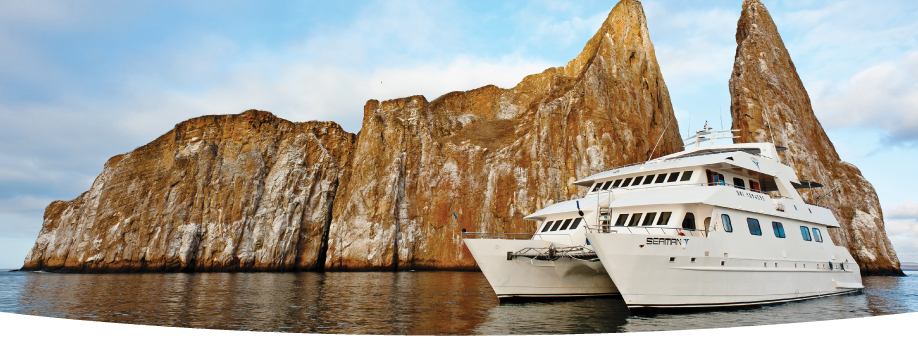

Galapagos Seaman Journey: Itinerary B
Enjoy one of the world's most famous natural laboratories while cruising on the Seaman Journey catamaran. Discover the wonders of the Galapagos as you explore this enchanting UNESCO World Heritage site, known as the "living museum and showcase of evolution". You'll get close to endemic species that seem unfazed by the presence of humans, like Giant Tortoises, Penguins, Sea Lions, Marine Iguanas, Frigate Birds, Blue Footed Boobies, and much more! Experience the beauty of the islands, swimming in crystalline and turquoise waters, snorkeling or kayaking. For birdwatchers, there will be plenty of opportunities to observe both native and migratory birds, as well as learning more of the wildlife at the Charles Darwin Center.
INCLUSIONS
• Arrival and Departure Transfers
• 4 Nights Accommodations
• Excursion to San Cristobal Island
• 4 Nights Accommodations
• Excursion to San Cristobal Island
• Excursion to Espanola Island and Suarez Point
• Excursion to Cormorant Point and Baroness Lookout
• Excursion to Cormorant Point and Baroness Lookout
• Excursion to Charles Darwin Station
• All Meals
• All Meals
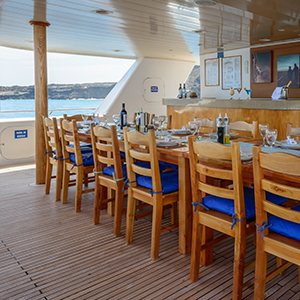
Arrive in San Cristobal:
Arriving in San Cristobal, you'll immediately sense a feeling of tranquility and harmony that's instilled on those who visit these islands. After passing through customs and immigration, meet your driver/guide for your transfer to the port and on to the Seaman Journey Catamaran.
The Seaman Journey has a maximum capacity of 16 passengers allowing both intimacy and camaraderie at the same time. Well-appointed staterooms, spacious sundecks, a bar, lounge and library, creates the perfect ambiance for a relaxing stay. Snorkeling gear and kayaks are also available for your aquatic activities. In addition, a bilingual naturalist guide will be accompanying you on all island expeditions. In the afternoon, we'll stop at the nearby Interpretation Center amid exuberant gardens and stunning ocean views. This is the oldest museum of Natural History in the Galapagos Islands which attempts to preserve the archipelago, offering conservation facts as well as the human and natural history of the islands.
(Dinner & Accommodations, Seaman Journey Catamaran)
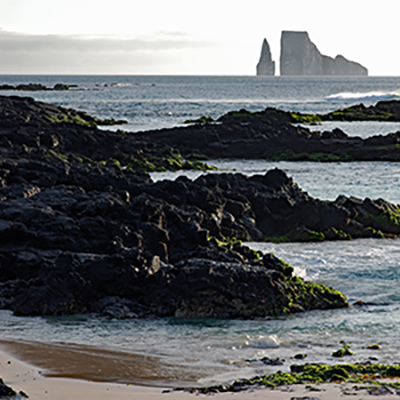
San Cristobal Island:
After breakfast, a short visit will take place at the Galapaguera; a good place to observe Galapagos tortoises in its natural habitat. San Cristobal island has several native species such as the San Cristobal Mockingbird, Lava Lizard, Chatham Leaf-toed Gecko, and tortoises. The beach is huge and serves as the ideal nesting zone for marine tortoises. Between January and May, it is common to find the footprints of the female tortoises who have climbed to the sand dunes to deposit their eggs.
After lunch we'll stop at Cerro Brujo; a beautiful white coral beach where you can swim and snorkel, as well as watch for birds. This is the coast where Charles Darwin first set foot in 1835. In this marvelous lava landscape, you'll be able to view seabirds like the blue-footed boobies, Nazca boobies, herons, frigate birds and numerous shore birds. The protected bay is well known for its young tortoises who are comfortable swimming without fear of predators.
The salt water pools located behind the sand dunes were used by the shoremen as a salt mine in order to preserve food for the local population. Among the fauna, your guide will point out the Chatham Mockingbird and the San Cristobal Lava Lizard, both species endemic to the island and unique to the area.
And with a little luck, maybe spot the little bird known as the "Pájaro Brujo", a bright red-cardinal flycatcher.
(All Meals & Accommodations, Seaman Journey Catamaran)
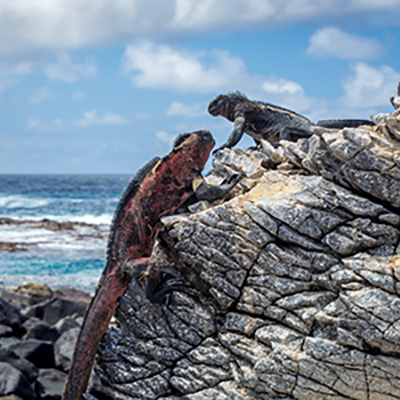
Española Island:
Located on the north-eastern coast of Hood, Gardner Bay offers an excellent beach to relax, swim and even kayak, plus the opportunity to observe sea lions. Here you can also observe sharks in the crystal clear ocean waters. At this site, one can see three species of Darwin finches: a subspecies of the large-billed cactus finch, which is similar to the large-billed terrestrial finch; the small-beaked ground finch and the singing finch, which is another endemic subspecies. While observing both resident and migratory birds are observed, it's worth to notice that this zone is vitally important for nesting marine tortoises, specially the Green Sea Turtle, one of the largest sea turtles and the only herbivore among the different species.
In the afternoon, we'll head to Suarez Point. This area is great for spotting blue-footed boobies, albatrosses and Nazca boobies. A beautiful site on the oceanfront, the large waved albatrosses use the cliffs as a launching pad. The famous attraction is the magnificent blowhole, spurting water high into the air at least from 50 to 75 meters high. Make sure you have your camera or phone handy as you'll have exceptional photograph opportunities.
(All Meals & Accommodations, Seaman Journey Catamaran)
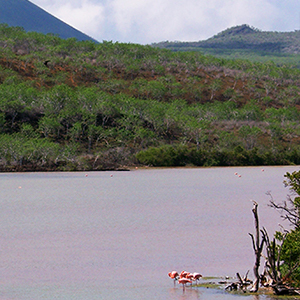
Floreana Island:
Our first stop will be Cormorant Point on Floreana Island. This site offers probably the best flamingo lagoon in the Galapagos and is also one of the largest in the islands. It's situated between two lava cones that give the area a special atmosphere. There are various species of shorebirds to observe besides flamingos; the most frequent are common stilts, white-checked pintail ducks, and other migratory birds. It is very interesting to see the two distinct beaches: "The Green Beach" (due to its high percentage of olivine crystals in the sand) and the "Flour Sand Beach" which is made up of coral.
In the afternoon, you'll visit Post Office Bay and Baroness Lookout. Historically, this site is the location of a wooden barrel that was placed in the 18th century by the crew of a whaling ship. It has been used since this time by marines and tourists as a post office. The idea is to carry letters or postcards to their destination by hand. Besides, this site was the landing area for some of the first colonists. We will continue to the north of the island and proceed to an elevated slope to enjoy a beautiful view at the Baroness lookout. It is said that Baroness Eloisa Von Wagner loved this place and spent several hours watching the horizon. Within walking distance (30 m) are the ruins of what is known as her house. From this lookout, the landscape covers the coastline from the Enderby islet to Post Office Bay, as well as Cerro Pajas, the pool of flamingos and wide forest of Palo Santo.
(All Meals & Accommodations, Seaman Journey Catamaran)
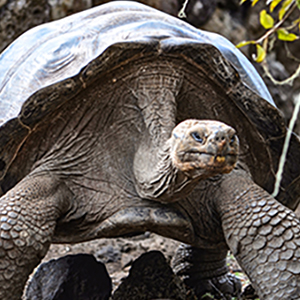
Santa Cruz Island:
After breakfast, you'll visit the National Park Information Center. Although the great majority of Galapagos visitors come here to observe and appreciate natural wonders, it's also interesting to learn how the protection and conservation of the islands are carried out. In addition to the center, the other attractions are the Van Straelen Exhibition Hall, and the Breeding and Rearing Center for young tortoises. The famous "Lonesome George" was cared for in this place, and was the only known living individual from his specific subspecies until his recent death in 2012. You'll also find many adult Galapagos tortoises living on the premises. After the morning excursion. you'll have a transfer to Baltra Airport for your return home or onward to your next Avanti Destination!
(All Meals & Accommodations, Seaman Journey Catamaran)
** Itinerary and inclusions are subject to change




